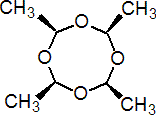|
metaldehyde
Molluscicide

NOMENCLATURE
Common name metaldehyde (BSI, E-ISO, F-ISO, JMAF, accepted in lieu of a common name)
IUPAC name r-2,c-4,c-6,c-8-tetramethyl-1,3,5,7-tetroxocane; 2,4,6,8-tetramethyl-1,3,5,7-tetraoxacyclo-octane
Chemical Abstracts name 2,4,6,8-tetramethyl-1,3,5,7-tetraoxacyclooctane; acetaldehyde tetramer (but see Composition)
CAS RN [108-62-3] tetramer; [37273-91-9] (metaldehyde, unspecified molecular formula); ([9002-91-9] homopolymer) EEC no. 203-600-2
PHYSICAL CHEMISTRY
Composition Metaldehyde is a tetramer of acetaldehyde; it is sometimes, incorrectly, referred to as a homopolymer of acetaldehyde. Mol. wt. 176.2 (tetramer) M.f. C8H16O4 (tetramer); (C2H4O)x (homopolymer) Form Crystalline powder. M.p. 246 ºC (sealed tube) B.p. Sublimes at 112-115 ºC (atmospheric pressure), with partial depolymerisation V.p. 6.6 ´ 103 mPa (25 °C) KOW logP = 0.12 Henry 3.5 Pa m3 mol-1 (calc.) S.g./density 1.27 (20 °C) Solubility In water 222 mg/l (20 °C). In toluene 530, methanol 1730 (both in mg/l, 20 °C). Stability Depolymerises and sublimes above 112 °C. F.p. 50-55 °C (Abel-Pensky closed cup)
COMMERCIALISATION
History Its slug-killing properties reported by G. W. Thomas (Gard. Chron., 1936, 100, 453). Manufacturers Lonza
APPLICATIONS
Mode of action Molluscicide with contact and stomach action. Metaldehyde-poisoned slugs secrete large quantities of slime, desiccate and die. Their mucus cells are irreversibly destroyed. Uses Control of slugs and snails in agriculture and horticulture. Phytotoxicity Non-phytotoxic when used as recommended. Formulation types GB; RB; Pellets. Selected products: 'Cekumeta' (Cequisa); 'Deadline' (Amvac); 'Hardy' (Chiltern); 'Metason' (Rimi); 'MifaSlug' (FCC); 'Tracker' (Barclay)
OTHER PRODUCTS
'Brits' (Doff Portland); 'Deadline Bullets' (Valent); 'Dixie' (GreenCrop); 'Escar-Go' (Chiltern); 'Luxan 9363' (Luxan); 'Metarex' (De Sangosse); 'Molotov' (Chiltern); 'Regel' (De Sangosse UK); 'Trigger' (Luxan) Discontinued products: 'Halizan' * (Tamogan); 'Meta Metaldehyde' * (Lonza); 'Meta The Molluscicide' * (Lonza); 'Meta' * (Lonza); 'Optimol' * (PBI, Zeneca)
ANALYSIS
Product analysis by gc/ms (using m-xylene as internal standard) after extraction of the homogenised material with trichloromethane.
MAMMALIAN TOXICOLOGY
Reviews T. Booze & F. Oehme, Vet. Hum. Toxicol., 27, 11-19 (1985). Oral Acute oral LD50 for rats 283, mice 425 mg/kg. Skin and eye Acute percutaneous LD50 for rats >5000 mg/kg. Not a skin irritant (rabbits). Not a skin sensitiser (guinea pigs). Inhalation LC50 (4 h) for rats >15 mg/l air. ADI 0.025 mg/kg b.w. Other Non-mutagenic, non-teratogenic. Toxicity class WHO (a.i.) II; EPA (formulation) III; II EC classification R10| Xn; R22
ECOTOXICOLOGY
Birds Acute oral LD50 for quail 170 mg/kg. Dietary LC50 (8 d) for quail 3460 ppm. Fish LC50 (96 h) for rainbow trout 75 mg/l. Daphnia EC50 (48 h) >90 mg/l. Algae EC50 (96 h) 73.5 mg/l. Bees LD50 (oral) >87 mg/bee; (contact) >113 mg/bee. Worms LC50 >1000 ppm. Other beneficial spp. No effects on aphids (Typhlodromus pyri, Aphidius rhopalosiphi).
ENVIRONMENTAL FATE
Soil/Environment Microbiological decomposition of metaldehyde to CO2 and water.
|